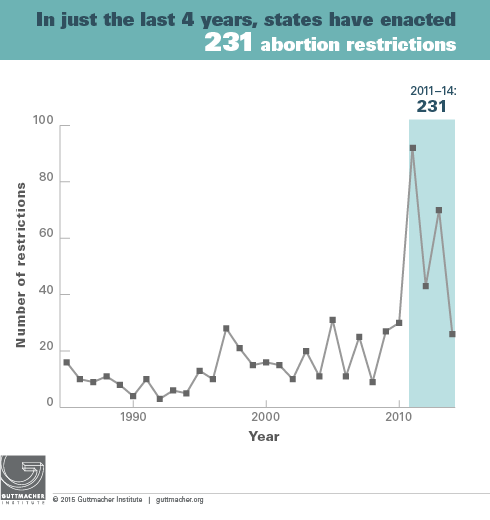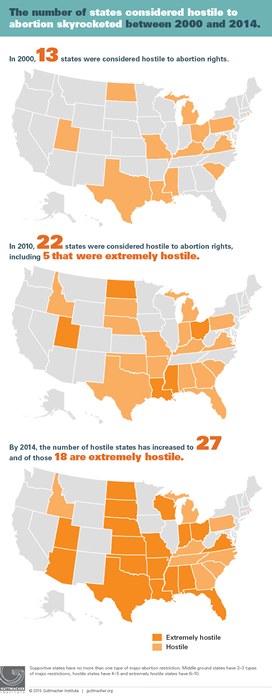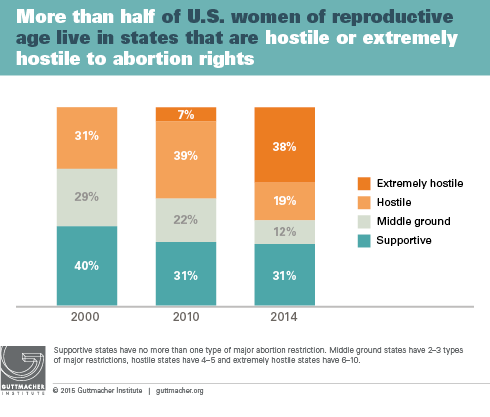During the 2014 state legislative session, lawmakers introduced 341 provisions aimed at restricting access to abortion. By the end of the year, 15 states had enacted 26 new abortion restrictions. Including these new provisions, states have adopted 231 new abortion restrictions since the 2010 midterm elections swept abortion opponents into power in state capitals across the country.
Bucking this tide, legislators in 17 states introduced 95 measures designed to expand access to abortion, more positive measures than in any year since 1990. Of these, four were signed into law: two provisions established buffer zones around abortion providers in Massachusetts and New Hampshire; the third repealed the pre-Roe abortion ban in Vermont; and the fourth eased counseling requirements for women seeking an abortion because of a fetal impairment in Utah. Moreover, on Election Day, voters in Colorado and North Dakota rejected ballot initiatives that would have conferred personhood on a fertilized egg by a two-to-one margin, even as voters in Tennessee approved an initiative expanding legislators’ authority to restrict abortion. States also took positive steps on other sexual and reproductive health and rights issues, enacting provisions requiring insurance coverage of all FDA-approved contraceptive methods with no cost-sharing in California; protecting confidentiality for individuals insured as dependents in Maryland; and allowing STI treatment for a patient’s partner in the District of Columbia.
The large number of recently enacted abortion restrictions has dramatically reshaped the landscape for women seeking an abortion (see A Surge of State Abortion Restrictions Puts Providers—and the Women They Serve—in the Crosshairs). In 2000, 13 states had four or five types of abortion restrictions in effect and so were considered hostile to abortion rights. In that year, no state had more than five types of abortion restrictions in effect. By 2010, 22 states were considered hostile to abortion rights; five of these had six or more restrictions, enough to be considered extremely hostile to abortion rights. By 2014, 27 states had enough restrictions to be considered hostile; 18 of these can now be considered extremely hostile. The entire South is now considered hostile to abortion rights, and much of the South, along with much of the Midwest, is extremely hostile to abortion rights.
The proportion of women living in hostile states has surged as well. In 2000, 31% of women of reproductive age lived in a state hostile to abortion rights, with no women living in a state with enough restrictions to be considered extremely hostile. By 2014, 57% of women lived in a state that is either hostile or extremely hostile to abortion rights.
Abortion Issues
The 26 abortion restrictions enacted in 2014 represent a significant decrease from the 70 that were enacted in 2013. Several factors likely contributed to this decline. First, legislatures in four states (Montana, Nevada, North Dakota and Texas) are not in session in even-numbered years, which are also election years; together, these four states enacted 15 restrictions in 2013. Second, election-year legislative sessions are typically several weeks shorter than sessions in non-election years. Finally, abortion increasingly competes for legislative time with other issues, including the minimum wage and the common core educational standards.
Nonetheless, the midterm election results provide good reason to be concerned about a renewed focus on restricting abortion in the upcoming 2015 legislative sessions. Republican legislators, who overwhelmingly oppose abortion rights, solidified their dominance in the states. Republicans will now control both legislative chambers in 30 states, three more than in 2014; in 23 of those states, the governor will also be Republican. Democrats will control both legislative chambers and the governor’s mansion in only seven states. In addition, the ballot initiative approved in Tennessee likely will open the door to additional restrictions in that state.
Major action in 2014 includes:
Abortion bans
- Repealing pre-Roe abortion ban. Vermont repealed its abortion ban that preexisted the 1973 Supreme Court decision in Roe v. Wade. Nonetheless, 11 states retain their pre-Roe abortion bans, even though they are not enforced (see Abortion Policy in the Absence of Roe).
- Banning early abortion. No state enacted a measure in 2014 to ban abortion in the first trimester. Federal courts struck down abortion bans in Arkansas (after 12 weeks of pregnancy) and North Dakota (six weeks of pregnancy). No state has a first-trimester ban in effect.
- Banning abortion in the second trimester. Mississippi enacted a measure to ban abortion at 18 weeks postfertilization based on the unsubstantiated assertion that a fetus can feel pain at that point. Mississippi is the only state to have such a restriction in effect. Ten states ban abortion at 20 weeks postfertilization, which is equivalent to 22 weeks LMP (see State Policies on Later Abortions).
- Banning sex-selective abortion. South Dakota enacted a measure criminalizing the provision of an abortion if the provider knows the women is obtaining the abortion for purposes of sex selection (see A Problem-and-Solution Mismatch: Son Preference and Sex-Selective Abortion Bans). Including this new provision, seven states (AZ, KS, NC, ND, OK, PA, SD) ban sex-selective abortion (see Abortion Bans in the Cases of Sex or Race Selection or Genetic Anomaly).
Buffer zones around abortion providers
- Supreme Court ruling. In June, the U.S. Supreme Court handed down its decision in McCullen v. Coakley, striking down a Massachusetts measure that had established a 35-foot protected zone around clinic entrances and exits.
- Buffer zones. In response to the U.S. Supreme Court decision in McCullen v. Coakley, Massachusetts enacted a new, smaller buffer zone that requires a protester to stay at least 25 feet away from the clinic’s entrance or driveway for up to eight hours after a police officer issues a dispersal order. New Hampshire also adopted a measure establishing a buffer zone of up to 25 feet; the state agreed to allow the measure to remain unenforced during the court case. Including Massachusetts, three states have established buffer zones around clinics, and 13 states have taken some steps to protect clinic access (see Protecting Access to Clinics).
Counseling and waiting periods
- Abortion counseling requirements. Utah adopted a measure that waives some of the state’s counseling requirements if a woman is obtaining an abortion in the case of a diagnosed fetal impairment. The law also waives the state’s requirement that the woman be offered the opportunity to view the image if an ultrasound is performed in such cases (see Requirements for Ultrasound). And a federal appeals court struck down a North Carolina law that would have required the provider to show the woman the ultrasound and describe the image to her; an earlier state law requiring an ultrasound before an abortion remains in effect.
Oklahoma added a requirement that abortion counseling include information on perinatal hospice availability in cases where a woman may be obtaining an abortion due to a fetal anomaly, and Louisiana added counseling materials exaggerating the negative psychological effects of abortion (see State Abortion Counseling Policies and the Fundamental Principles of Informed Consent). By year’s end, 27 states had mandated inclusion of counseling elements designed to dissuade a woman from having an abortion (see Counseling and Waiting Periods for Abortion).
-
Waiting periods. Alabama extended the waiting period between counseling and obtaining an abortion from 24 to 48 hours. Missouri extended its waiting period from 24 to 72 hours; Gov. Jay Nixon’s (D) veto of the measure was overridden by the legislature. Four states (AL, MO, SD and UT) have waiting periods longer than 24 hours (see Counseling and Waiting Periods for Abortion).
Medication abortion
- Mandated use of outdated FDA protocol. Oklahoma enacted a measure requiring use of the outdated FDA protocol; enforcement of the measure is blocked pending court action (see Medication Abortion Restrictions Burden Women and Providers—and Threaten U.S. Trend Toward Very Early Abortion). A federal appeals court blocked enforcement of a similar law in Arizona and the case has been appealed to the U.S. Supreme Court. In addition, a federal appeals court upheld a similar Texas law and the North Dakota Supreme Court upheld a similar law in that state (the law mandates use of the FDA protocol, but could also be interpreted as banning the use of medication abortion entirely). At year’s end, two states (OH, TX) had mandated use of the outdated protocol (see Medication Abortion).
- Use of telemedicine. State courts ruled in opposite directions on the issue of using telemedicine for medication abortion (see Medication Abortion Restrictions Burden Women and Providers—and Threaten U.S. Trend Toward Very Early Abortion). A court in Wisconsin cleared the way for enforcement of the state’s ban, while the Iowa Supreme Court temporarily blocked enforcement of the state’s ban. Taking these decisions into account, 16 states bar use of telemedicine for medication abortion (see Medication Abortion).
Targeted regulation of abortion providers (TRAP)
- Admitting privileges. Louisiana and Oklahoma both enacted laws requiring abortion providers to have admitting privileges at hospitals within 30 miles of the clinic (see TRAP Laws Gain Political Traction While Abortion Clinics—and the Women They Serve—Pay the Price). Supporters of abortion rights filed legal action against both measures. The Oklahoma provision has been blocked pending resolution of the case; in Louisiana, the court barred enforcement against providers who do not have admitting privileges. In 2014, federal courts struck down laws mandating admitting privileges in Alabama and Mississippi; both decisions have been appealed, and enforcement of the laws is blocked while legal action continues. A similar law in Texas was upheld by a federal appeals court, and the law is in effect pending additional legal action. At year’s end, five states (MO, ND, TN, TX and UT) had laws in effect mandating that abortion providers have admitting privileges (see Targeted Regulation of Abortion Providers).
- Clinic regulation. A new provision in Arizona allows for unannounced inspections of abortion clinics, and a new measure enacted in Indiana requires inspections at least annually. A federal appeals court upheld a set of clinic regulations in Texas, but enforcement of the requirements—which include hallway width requirements, parking requirements and hospital-grade ventilation systems—was blocked by the U.S. Supreme Court pending further legal action (see TRAP Laws Gain Political Traction While Abortion Clinics—and the Women They Serve—Pay the Price). Accounting for this legal action, 24 states have excessively burdensome clinic regulations in effect (see Targeted Regulation of Abortion Providers).
Minors’ access to abortion services
- Parental involvement. Alabama enacted a measure requiring that the parental consent form be either notarized or witnessed; the minor’s parent must also provide a certified birth certificate and photographic ID to prove parenthood. It also expanded requirements for a minor seeking to obtain a judicial bypass of the consent requirement by requiring the state attorney general to participate in the proceedings, permitting the court to appoint a guardian ad litem for the fetus and removing confidentiality protections for the minor. Thirty-eight states mandate parental involvement for a minor seeking an abortion (Parental Involvement in Minors’ Abortions).
- Crossing state lines. Arizona enacted a measure making it illegal to assist a minor in obtaining an abortion without parental consent; three states (AZ, AR, MO) have such requirements in effect.
Insurance coverage of abortion
- Private insurance. A new measure in Indiana restricts almost all abortion coverage in all private health plans except under limited circumstances, and a new measure in Georgia severely restricts abortion coverage in plans sold on the health exchange established under the Affordable Care Act. Including these new laws, nine states restrict abortion coverage in all private plans (ID, KS, KY, MI, MO, NE, ND, OK and UT) and 25 states limit abortion coverage in plans sold on the exchanges (see Restricting Insurance Coverage of Abortion).
- Public funding. Alaska adopted a measure that would limit coverage of abortion for Medicaid enrollees; the provision is blocked pending the outcome of legal action, and for now, the state is continuing to fund medically necessary procedures (see Insurance Coverage of Abortion: Beyond the Exceptions for Life Endangerment, Rape and Incest). Including Alaska, 17 states have policies to pay for all or most medically necessary abortions for Medicaid enrollees (State Funding of Abortion Under Medicaid).
Family Planning and Access to Related Services
No state adopted new restrictions on publicly funded family planning providers in 2014. Nine states currently prohibit certain types of providers from receiving state funds (AZ, CO, IN, KS, NC, OH, OK, TX and WI), and three states have a priority system in place to guide the distribution of funds (MI, OH and TX) (see State Family Planning Funding Restrictions). In addition, no state instituted new disproportionate cuts to family planning funding.
Significantly, all major action on family planning and related services in 2014 involved attempts to expand access to needed care and services:
- Contraceptive Coverage. The contraceptive coverage guarantee included in the Affordable Care Act sought to give women access to the contraceptive method of their choice with no cost-sharing. Although the provision has had a substantial and rapid impact on eliminating out-of-pocket costs, important gaps in coverage remain.(see Impact of the Federal Contraceptive Coverage Guarantee on Out-of-Pocket Payments for Contraceptives: 2014 Update). In response, California adopted a measure that ensures coverage of all FDA-approved methods with no cost-sharing. It also blocks insurers from utilizing so-called step therapy, under which a woman could need to try one or more less expensive alternatives before being covered for the method of her choice, or requiring prior authorization for a woman seeking some contraceptive methods. No other state has adopted a similar measure.
- Confidentiality for individuals insured as dependents. Billing and claims processing procedures widely used in private health insurance routinely, albeit inadvertently, make it impossible for anyone insured as a dependent on someone else's policy to obtain sensitive services confidentially (see A New Frontier in the Era of Health Reform: Protecting Confidentiality for Individuals Insured as Dependents). In 2014, Maryland enacted a measure designed to protect confidentiality for insured dependents; including this new law, 10 states have adopted provisions aimed at protecting dependent's confidentiality (see Protecting Confidentiality for Individuals Insured as Dependents).
- Expedited partner treatment. The District of Columbia adopted a provision that permits health care practitioners to provide at least some STI treatment for the partner of a patient diagnosed with an STI without first examining the partner. In addition to the new DC law, 28 states permit some expedited partner treatment (see Partner Treatment for STIs).
Sex Education
Inclusion of information about either contraception or abstinence was not a major issue in state legislatures in 2014. Instead, nine states (CA, CT, LA, MA, NM, PA, RI, SC and UT) enacted measures related to education on sexual assault awareness and prevention. Including these new provisions, 20 states and the District of Columbia require that sex education include information about skills for avoiding coerced sex (see Sex and HIV Education).


